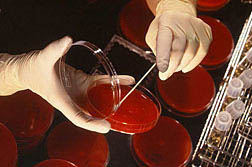This page has been archived and is being provided for reference purposes only. The page is no longer being updated, and therefore, links on the page may be invalid.
Hyperspectral Imaging Speeds Detection of Campylobacter
By Sharon DurhamAugust 25, 2010
A type of high-tech imaging can be used to distinguish the foodborne pathogen Campylobacter from other microorganisms as quickly as 24 hours after a sample is placed on solid media in a Petri dish, according to a study published by U.S. Department of Agriculture (USDA) scientists.
The researchers, with USDA's Agricultural Research Service (ARS), used technology called hyperspectral imaging, which combines digital imaging with spectroscopy, to provide hundreds of individual wavelength measurements for each image pixel. ARS is the chief scientific research agency of USDA.
According to the study, microorganisms grown on solid media carry unique spectral fingerprints in the specific portion of the electromagnetic spectrum. A hyperspectral imager identifies these fingerprints by measuring light waves that bounce off or through these objects.
Unlike the human eye, which sees only visible light, hyperspectral imaging can detect visible light as well as light from the ultraviolet to near-infrared ranges. Hyperspectral imaging may also be applicable to other pathogen detection studies.
Campylobacter infections in humans are a major cause of bacterial foodborne illness both in the United States and other countries throughout the world. Growing Campylobacter directly on solid media has been an effective method to isolate this organism, but distinguishing Campylobacter from non-Campylobacter microorganisms is difficult because different bacteria can often look very similar.
A research team led by ARS electronics engineer Seung-Chul Yoon at the agency's Quality and Safety Assessment Research Unit in Athens, Ga., developed the imaging technique to detect Campylobacter colonies on solid media in 24 hours. Normally, isolation and detection for identification of Campylobacter from foods like raw chicken involve time-consuming or complicated laboratory tests that may take several days to a week.
This "sensing" technology, which was nearly 100 percent accurate with pure cultures of the microorganisms, could be used for early detection of presumptive Campylobacter colonies in mixed cultures. The researchers are working toward developing a presumptive screening technique to detect Salmonella and Campylobacter in food samples.
Other ARS team members included research leader Kurt Lawrence, agricultural engineer Bosoon Park, animal physiologist William Windham, and food technologists John Line and Peggy Feldner. Line is at the ARS Poultry Microbiological Safety Research Unit, also in Athens. Gregory Siragusa of Danisco, in Waukesha, Wis., also collaborated on the study.
Findings from this study were published in the journal Sensing and Instrumentation for Food Quality and Safety. This research supports the USDA priority of ensuring food safety.

